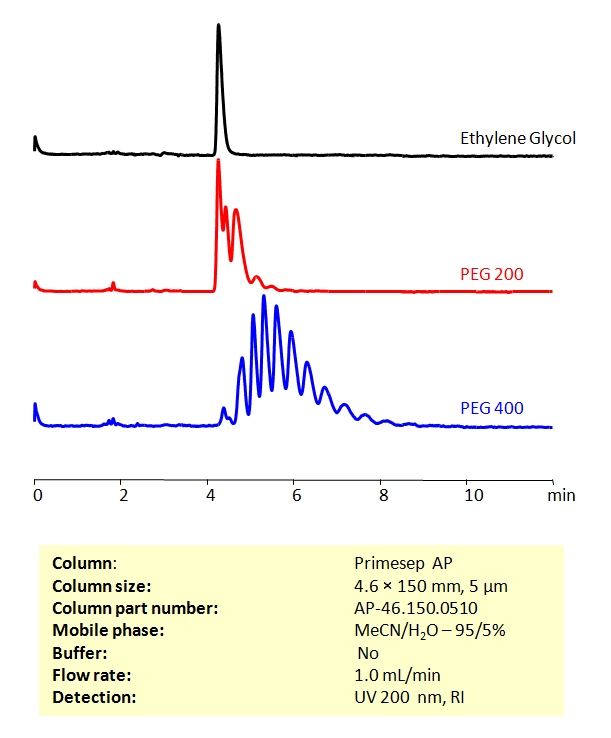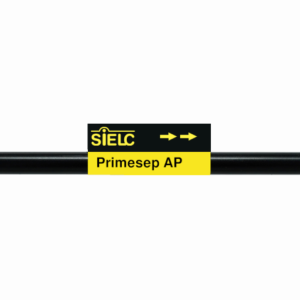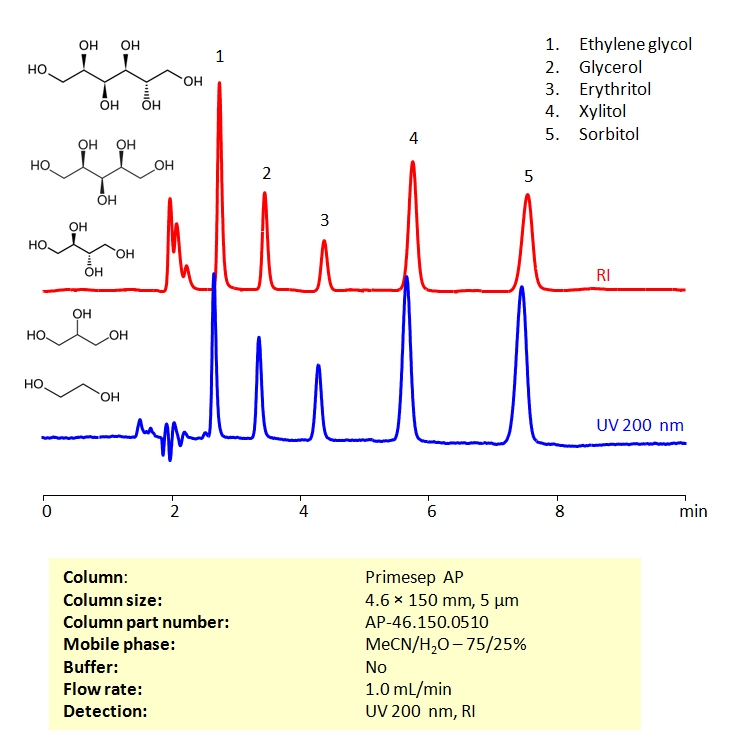| CAS Number | 107-21-1 |
|---|---|
| Molecular Formula | C2H6O2 |
| Molecular Weight | 62.07 |
| InChI Key | LYCAIKOWRPUZTN-UHFFFAOYSA-N |
| LogP | -1.4 |
| Synonyms |
|
Applications:
HPLC Method For Analysis of Ethylene Glycol and Polyethylene Glycol (PEG) on Primesep AP Column
September 14, 2021
HPLC Method for Ethylene Glycol, Polyethylene Glycol on Primesep AP by SIELC Technologies
High Performance Liquid Chromatography (HPLC) Method for Analysis of Ethylene glycol, PEG 200, PEG 400.
Polyethylene glycol (PEG) has a low toxicity and is used in a variety of products (creams, laxatives, lubricants). When attached to various protein medications, polyethylene glycol allows a slowed clearance of the carried protein from the blood. This makes for a longer acting medicinal effect, reduces toxicity, and allows longer dosing intervals.
HILIC separation can be used to determine polyethylene glycol content in various formulations using ELSD, RI detection, or LC/MS detection. HPLC separation of oligomers can be achieved by changing the amount of acetonitrile.
| Column | Primesep AP, 4.6 x 150 mm, 5 µm, 100 A, dual ended |
| Mobile Phase | MeCN/H2O – 95/5% |
| Buffer | No |
| Flow Rate | 1.0 ml/min |
| Detection | UV, 200 nm, RI |
| LOD* | Ethylene glycol 6 ppm (UV) |
| Class of Compounds | Diol |
| Analyzing Compounds | Ethylene Glycol, Polyethylene Glycol |
Application Column
Primesep AP
Column Diameter: 4.6 mm
Column Length: 150 mm
Particle Size: 5 µm
Pore Size: 100 A
Column options: dual ended
Polyethylene Glycol

HPLC Method For Simultaneous Quantification of Sugar Alcohols (Polyols) on Primesep AP
September 9, 2021
HPLC Method for Glycerol, Xylitol, Sorbitol, Erythritol, Ethylene Glycol on Primesep AP by SIELC Technologies
High Performance Liquid Chromatography (HPLC) Method for Analysis of Glycerol, Xylitol, Sorbitol, Erythritol, Ethylene Glycol.
Ethylene glycol is an organic compound with the formula (CH2OH)2. It has a variety of uses, but it is primarily found as an antifreeze agent. Those coolants are often used in automobiles and air-conditioning systems. In the plastic industry, ethylene glycol is a precursor to polyester fibers and resins.
Glycerol is an organic compound with the molecular formula C3H8O3. It is a humectant, solvent, and sweetener that used in various industries including skin care, hygiene products, pharmaceuticals, and food. It is said to improve lubrication and smoothness in products. Historically, before ethylene glycol took over, glycerol was used as a antifreeze.
Erythritol is a naturally accruing sugar alcohol with the chemical formula C4H10O4. It is is typically used as a sweetener and flavor enhancer in a large variety of foods and bevarages, including but not limited to tea, juice blends, soft drinks, cookies, biscuits, sugar-free chewing gum, and confections. It does lead to a noticeably different texture in baked products if used as a sugar replacement.
Xylitol is a sugar alcohol with the chemical formula C5H12O5. It is primarily used as a sugar supplement in confections, toothpaste, and drugs. It is considered a safe option for those with diabetes as it has negligible effects on blood sugar. It is said to produce a cooling sensation when interacting with moisture, which makes it an interesting additive to textiles.
Sorbitol is a sugar alcohol with the chemical formula C6H14O6. It is used primarily as a sugar substitute, but it also provides some dietary energy. Medically, it can be used as a laxative. In modern cosmetics, it is also used as a humectant and thickener.
Glycerol, Xylitol, Sorbitol, Erythritol, Ethylene Glycol can be retained and analyzed using the Primesep AP stationary phase column. The analysis utilizes an isocratic method with a simple mobile phase consisting of water and acetonitrile (MeCN). Detection is performed using UV.
| Column | Primesep AP, 4.6 x 150 mm, 5 µm, 100 A, dual ended |
| Mobile Phase | MeCN/H2O – 75/25% |
| Buffer | No |
| Flow Rate | 1.0 ml/min |
| Detection | UV 200 nm, RI |
| Class of Compounds |
Drug, Basic, Hydrophobic, Ionizable, Zwitterionic |
| Analyzing Compounds | Glycerol, Xylitol, Sorbitol, Erythritol, Ethylene Glycol |
Application Column
Primesep AP
Column Diameter: 4.6 mm
Column Length: 150 mm
Particle Size: 5 µm
Pore Size: 100 A
Column options: dual ended
Ethylene Glycol
Glycerol
Sorbitol
Xylitol





